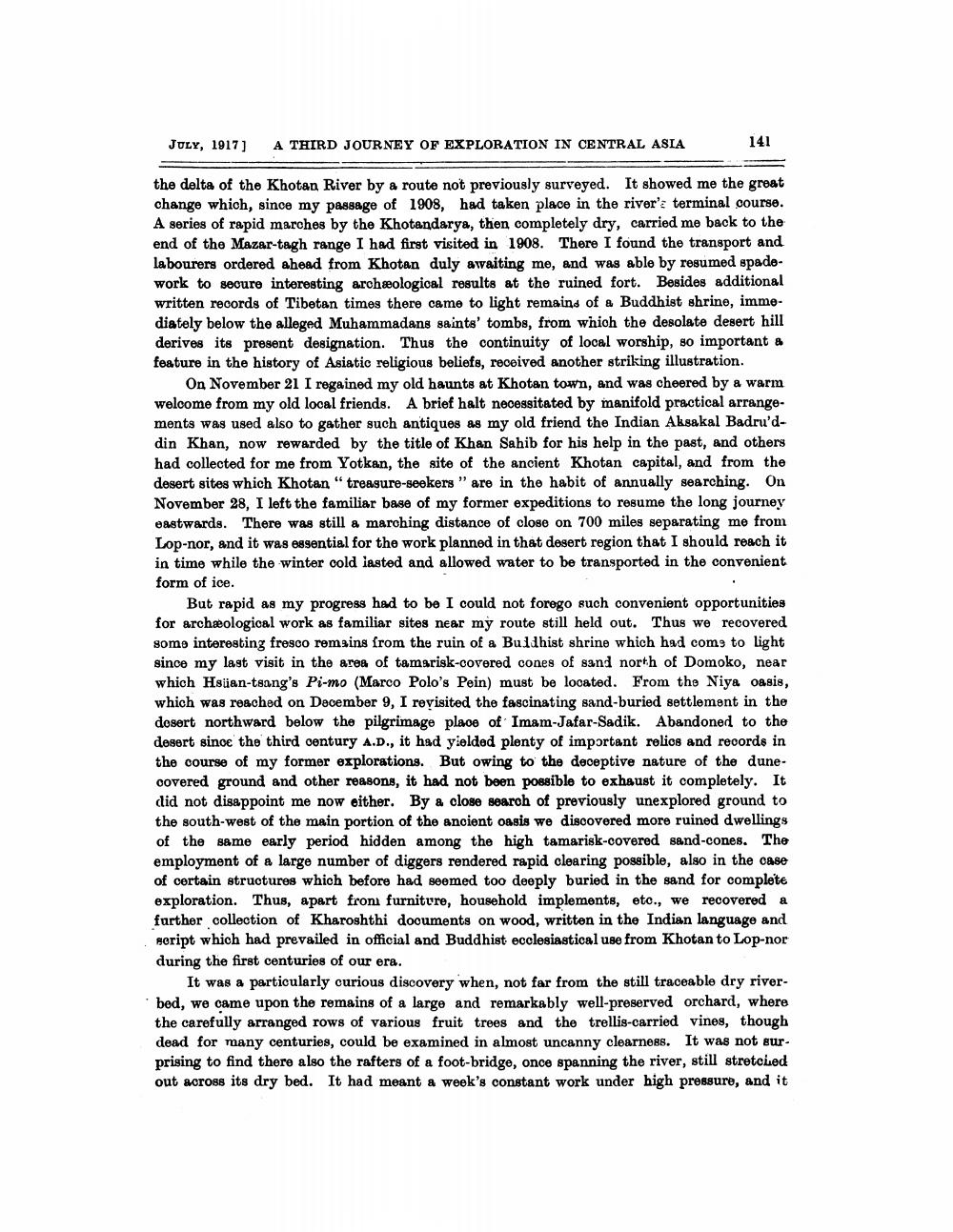________________
JULY, 1917]
A THIRD JOURNEY OF EXPLORATION IN CENTRAL ASIA
141
the delta of the Khotan River by a route not previously surveyed. It showed me the great change which, since my passage of 1908, had taken place in the river's terminal course. A series of rapid marches by the Khotandarya, then completely dry, carried me back to the end of the Mazar-tagh range I had first visited in 1908. There I found the transport and labourers ordered ahead from Khotan duly awaiting me, and was able by resumed spadework to secure interesting archeological results at the ruined fort. Besides additional written records of Tibetan times there came to light remains of a Buddhist shrine, immediately below the alleged Muhammadans saints' tombs, from which the desolate desert hill derives its present designation. Thus the continuity of local worship, so important & feature in the history of Asiatic religious beliefs, received another striking illustration.
On November 21 I regained my old haunts at Khotan town, and was cheered by a warm welcome from my old local friends. A brief halt necessitated by manifold practical arrangements was used also to gather such antiques as my old friend the Indian Aksakal Badru'ddin Khan, now rewarded by the title of Khan Sahib for his help in the past, and others had collected for me from Yotkan, the site of the ancient Khotan capital, and from the desert sites which Khotan "treasure-seekers" are in the habit of annually searching. On November 28, I left the familiar base of my former expeditions to resume the long journey eastwards. There was still a marching distance of close on 700 miles separating me from Lop-nor, and it was essential for the work planned in that desert region that I should reach it in time while the winter cold lasted and allowed water to be transported in the convenient form of ice.
But rapid as my progress had to be I could not forego such convenient opportunities for archeological work as familiar sites near my route still held out. Thus we recovered some interesting fresco remains from the ruin of a Buldhist shrine which had come to light since my last visit in the area of tamarisk-covered cones of sand north of Domoko, near which Hsian-tsang's Pi-mo (Marco Polo's Pein) must be located. From the Niya oasis, which was reached on December 9, I revisited the fascinating sand-buried settlement in the dosert northward below the pilgrimage place of Imam-Jafar-Sadik. Abandoned to the desert since the third century A.D., it had yielded plenty of important relics and records in the course of my former explorations. But owing to the deceptive nature of the dunecovered ground and other reasons, it had not been possible to exhaust it completely. It did not disappoint me now either. By & cloge search of previously unexplored ground to the south-west of the main portion of the ancient oasis we discovered more ruined dwellings of the same early period hidden among the high tamarisk-covered sand-cones. The employment of a large number of diggers rendered rapid clearing possible, also in the case of certain structures which before had seemed too deeply buried in the sand for complete exploration. Thus, apart from furniture, household implements, etc., we recovered a further collection of Kharoshthi documents on wood, written in the Indian language and Hoript which had prevailed in official and Buddhist ecclesiastical use from Khotan to Lop-nor during the first centuries of our era.
It was a particularly curious discovery when, not far from the still traceable dry riverbed, we came upon the remains of a large and remarkably well-preserved orchard, where the carefully arranged rows of various fruit trees and the trellis-carried vines, though dead for many centuries, could be examined in almost uncanny clearness. It was not surprising to find there also the rafters of a foot-bridge, once spanning the river, still stretched out across its dry bed. It had meant a week's constant work under high pressure, and it




